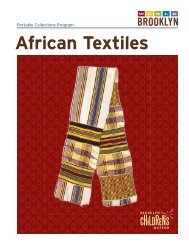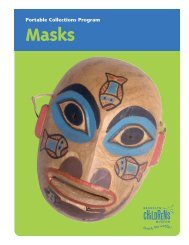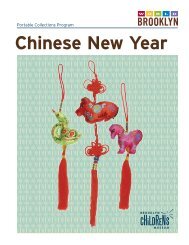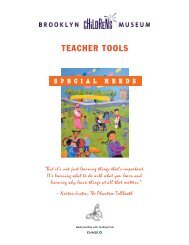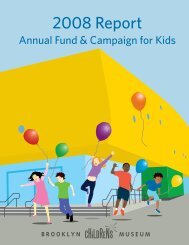Telling Stories Through Objects - Brooklyn Children's Museum
Telling Stories Through Objects - Brooklyn Children's Museum
Telling Stories Through Objects - Brooklyn Children's Museum
You also want an ePaper? Increase the reach of your titles
YUMPU automatically turns print PDFs into web optimized ePapers that Google loves.
■ INFORMATION FOR THE TEACHER ■<br />
Introduction: Every Object Has a Story to Tell (continued)<br />
section following this Introduction and opportunities<br />
for students to research can be found throughout the<br />
activities.<br />
The arts of telling and listening<br />
to stories<br />
People are always telling stories. When their parent or<br />
caretaker asks your students what they did at school<br />
today, how do they answer? That one simple question<br />
may lead a student to tell any number of stories.<br />
“You’ll never guess what happened on the playground<br />
today!” “I was on the way home from school<br />
when…” “Today my best friend did the funniest<br />
thing!” We all know, however, that even a fascinating<br />
story gains interest when it is well told.<br />
In the course of using this case, you may want to<br />
work with your students on different techniques to<br />
make their storytelling more exciting. The DVD in the<br />
case provides examples of story telling for children.<br />
Show them how varying their tone of voice can add<br />
nuance to their stories. Urge them to practice<br />
speaking softly to indicate secrecy, or loudly to<br />
indicate excitement. Their timbre can also help them<br />
differentiate between characters. They may represent<br />
a masculine or gruff-voiced character by speaking<br />
very low, or a feminine or shrill character by speaking<br />
warmly or higher. They can have fun repeating the<br />
same sentence with different expression—sad, loving,<br />
angry, regal, military, and so on.<br />
Students can also help create excitement and suspense<br />
by varying the pace at which they tell their<br />
tales. A dramatic pause can keep their audience on<br />
the edge of its seat. Gestures and simple sound effects<br />
may also be used to their advantage when telling<br />
stories, but remind your students that they should<br />
not overdo it on these features—their words are what<br />
will keep the story moving along.<br />
It is also important for your students to keep in mind<br />
that telling a story they have written or read does not<br />
mean they have to recite it from memory. In telling<br />
the story, they want it to seem fresh, as though it<br />
TELLING STORIES THROUGH OBJECTS 5<br />
were happening right in front of their listeners. To do<br />
this, they may need to read a story several times and<br />
recreate the story as an unfolding experience in their<br />
minds. That experience creates mental landmarks<br />
from which the story in their own words will spin out.<br />
Tell your students not to worry about the words coming<br />
together just so—just start at the beginning, get<br />
yourself through the middle, and come to the end.<br />
Everyone’s words and style of storytelling will be<br />
unique to him or her alone. Your students do not<br />
need to imitate any other storyteller. If they have<br />
confidence that their stories are good, they have only<br />
to tell it in their own way and their audience will listen<br />
with rapt attention.<br />
Listening to stories is also a skill you can help your<br />
students cultivate. Explain to them that just as telling<br />
a story is not a recitation from memory but an active<br />
experience, listening to a story is a participatory rather<br />
than a passive act. When you read or tell a story to<br />
them, ask them to build a theater in their minds and<br />
to transform the words they hear into scenes, characters,<br />
and unfolding events. Stop at moments and ask<br />
them to elaborate on the story. What do they see<br />
that’s not in the story? What are the characters<br />
wearing? Have them describe the scenery. What do<br />
they think the characters feel about each other? What<br />
do they think could happen next and how might the<br />
story end?<br />
<strong>Objects</strong> and stories have a natural affinity. Both involve<br />
imagination, detail, character, event. They are mutually<br />
enlivening. Hitched together, as they are in this<br />
case, they can heighten students’ interest in each and<br />
serve to increase their abilities to observe, to imagine,<br />
to read, to write, to shape a part of the world. ❑<br />
Words in boldface have been included in the Vocabulary<br />
Words section on page 23.



